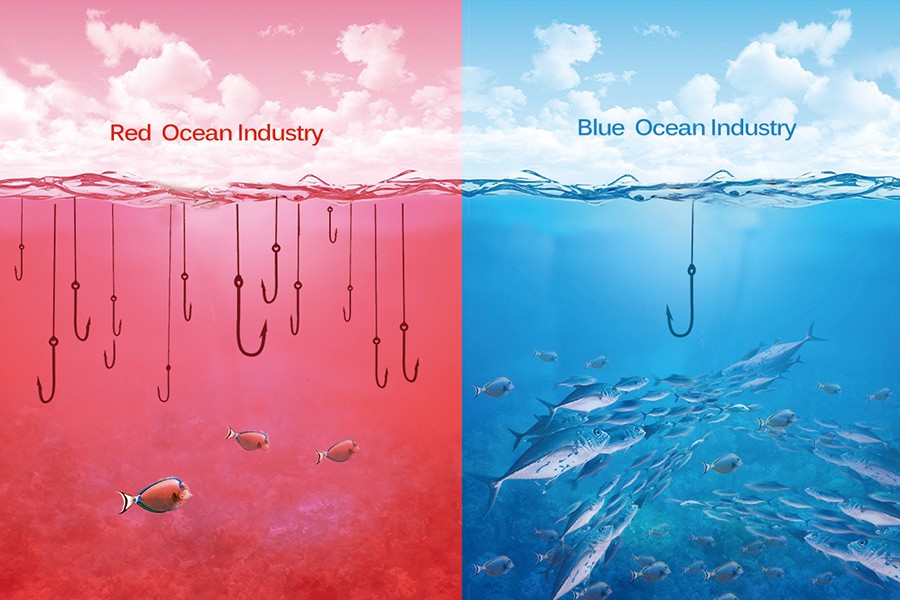Blog / Leadership & Transformation
What is a Blue Ocean Strategy?
Categories

A Blue Ocean Strategy is a unique way to enter a market before competition. A “Blue Ocean” market is an undisputed ocean, without competitors. A shark-less ocean where safe navigation is possible. At least until other companies enter the same market.
Blue Ocean Strategy: Where to start
In 2005, W. Chan Kim and Renée Mauborgne published a book that, even today, is taken as a reference by many business strategists. The book was called "Blue Ocean Strategy".
But let's take a step back. Today, in the era of Industry 4.0, many mistakenly believe that to make a company intelligent and competitive it is enough to invest in new technologies, to be introduced in every part of the company itself: from design, to production, to warehouse, to marketing, to supply chain management and so on. Unfortunately, this is not always the case: "garbage in, garbage out" was once said. A badly functioning company will continue to do so, even if it is full of computers. What needs to be done, however, is to review things from the beginning, starting from the business model. Once the business model has been created from scratch (or revised), you can proceed with the classic SWOT analysis and only then start choosing the most suitable technologies. W. Chan Kim and Renée Mauborgne tell us just that. The book does not talk about technology, but only about strategy and business model. Still, “Blue Ocean Strategy” has sold over 4 million copies, is published in 46 languages and is a bestseller on five continents, named by Fast Company as one of the most influential leadership books in its Leadership Hall of Fame.
Blue Ocean Strategy: Theory & Examples
Now let's see what are the basic principles introduced by the authors. Why is Blue Ocean strategy important? The Blue Ocean strategy suggests that it is better for a company to operate in uncontested markets (called “blue oceans”) instead of fighting competition in existing spaces (“red oceans”).

It is useless to open a new café, there are already many. Better to open a place where you can read the newspaper or a book, play chess, etc. and maybe, in the meantime, have a coffee. A bit like Starbucks did, which, in fact, has become the leader in its market segment. It is therefore the idea of trying to find spaces by creating and capturing new demand and making competition irrelevant. Irrelevant because, often, it does not exist. So how to create a Blue Ocean strategy, then? It is innovation that makes winning. And technology is at the service of innovation, because it makes it possible. Another example of a Blue Ocean strategy is Netflix. Netflix created a new market space by being the first to sell TV shows on the Internet. No one else was doing it. In this way, the company made competition irrelevant, creating new demand for a service that was not available on the market. Netflix has managed to break the trade-off between value and cost by providing better value than traditional TV (because you can watch any show you want at any time) at a lower cost than cable TV. The Blue Ocean strategy is based on the ability to create a new market demand, rather than sharing it with other players in the sector. Based on the study of 150 strategic initiatives developed in more than 100 years in 30 sectors, the authors argue that lasting success does not derive from the battle against competitors but precisely from the creation of "blue oceans", ie new untapped market spaces. Companies should create demand in a new market characterized by low competition rather than compete with other companies for the same objectives.
The attributes of a Blue Ocean Strategy
So what are the attributes of the Blue Ocean strategy? This approach has three key features:
Low competition: The Blue Ocean strategy is characterized by little or no competition. The players in the sector redefine the structures and boundaries of the market, create new demand and penetrate uncontested areas, making competition irrelevant.
Good value for money and affordable prices: Value innovation is a key aspect of the Blue Ocean strategy. While conventional market strategies seek a compromise between value and cost, the new strategy shifts from this line of thinking by eliminating or reducing the factors that create competition and introducing new dynamics. Such new market dynamics help businesses achieve low cost and differentiation.
Role of large enterprises: Large enterprises have the resources to introduce products with unique characteristics and create new demand. For example, in 2003 Apple ventured into the digital music market by introducing iTunes. The new product has helped create new demand by allowing users to download music on the go at lower prices. Within this new market, competition from traditional music distribution sources has been rendered irrelevant.

Blue versus Red
In a "Red Ocean" environment, the market is more difficult and crowded as competitors try to steal shares from each other. As firms have to compete with each other, prices fall, profits fall, and growth is limited to the size of the current market. Products become commodities or shrink into niche segments, and fierce competition makes the ocean red as blood. All sectors operating within an existing market space are defined as Red Ocean. In this case the rules of the competitive market must be followed and the defined boundaries of the sector are accepted. The main differences between the Blue Ocean and Red Ocean strategies are:
Market: The Red Ocean strategy focuses on the existing market, while the Blue Ocean strategy focuses on new and unique dynamics.
Competition: The Red Ocean strategy involves fierce commercial competition, while the Blue Ocean strategy aims to discover new markets that neither existing companies nor consumers know about. In these new markets, there is little or no direct competition.
Factors of Differentiation: A Red Ocean is populated with many products, so price is an essential differentiator. On the other hand, there are many differentiating variables in a Blue Ocean.
Demand: Companies in a Red Ocean compete with each other to meet existing market needs. On the contrary, the companies of a Blue Ocean create new demand through creativity and innovation.
Start your transformation today!
Make a profound change in your business model and innovate in every area of your company. We have experienced faculty board members that will guide you throughout your digital transformation. Check out our Global MBA in Digital Transformation with AI.




